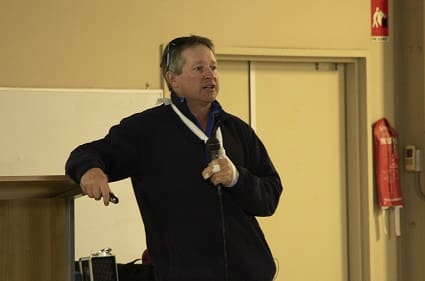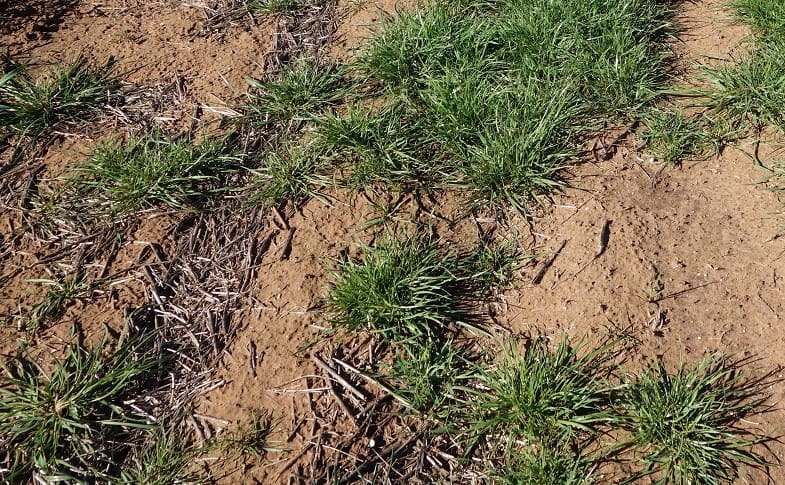Ask a WeedSmart Expert
THE Liverpool Plains in northern New South Wales is a hot spot for herbicide resistance.
Growers have been doing battle with glyphosate and Group A and Group B resistant ryegrass since the 2000s, along with high levels of glyphosate resistance in milk thistle and rising resistance in feathertop Rhodes grass, barnyard grass and liverseed grass.

Private agronomist, Peter McKenzie, recommends having a range of weed control tactics in place before pre-emergent herbicides are strategically added to the winter program.
Private agronomist, Peter McKenzie, is working with growers on the Liverpool Plains around Quirindi to integrate the use of pre-emergent herbicides into their winter cropping program.
“Pre-emergents are a useful tool to have in the weed control toolbox. But we need to use them effectively when we decide to pull them out of the cupboard,” Mr McKenzie said.
“These herbicides have a place in both the winter and summer cropping programs provided they are well-supported with several other tactics. We need to be chipping weeds, using the optical sprayers for first and second knocks to make more economical use of herbicide, mowing verges and getting into harvest weed seed control.”
When all these other tactics are in place, Mr McKenzie reckons that’s the time to consider the strategic use of pre-emergent herbicides.
Disc seeders
Up to 80 per cent of Liverpool Plains growers are using disc seeders to handle high levels of crop residue when seeding winter crops, and to take advantage of limited planting opportunities.
Mr McKenzie said this presented some challenges, particularly when using pre-emergent chemistry for ryegrass control, but it could still be done effectively in certain circumstances.
Although most product labels recommend knife points and press wheel planters for ryegrass pre-emergents, the use of disc seeders is often not illegal.
Growers must be aware that herbicide companies are unlikely to accept any responsibility for crop damage that may occur if the seeder does not achieve sufficient soil throw to separate herbicide from the seed line. As always, read the label carefully and ask for advice.
If you are considering adding pre-emergent herbicides to the weed control program on your farm, the free, online Diversity Era course is a great way to learn more and avoid the pitfalls.
Check it out at www.diversityera.com/courses/pre-emergent-herbicides-101
Should I use pre-ems in a paddock with weedy patches?
Short answer: Possibly.
Longer answer: Satellite imagery is a great way to identify and map weedy patches, using services such as Satamap. Once the patches are mapped it is easier to manage these patches differently.
One effective way is to harvest these areas lower, and using a homemade or commercial chaff chute to concentrate weed seeds onto the inhospitable environment of CTF wheeltracks. Using this approach, glyphosate resistant ryegrass patches can be dramatically reduced in one season – down by 70–75 per cent. Not only can this drive down the weed numbers for the following year, it can also make the summer post-emergent spraying more effective because the chaff reduces the amount of dust thrown up by the sprayer tyres.
An alternate strategy for patches where harvest weed seed control is not practical is to apply a pre-emergent prior to the first spring storms to the patches that have been previously mapped. This is likely to substantially reduce the weed pressure over the following summer. Access to an optical sprayer (or chippers) can be very cost-effective in quickly cleaning up any escapes.
Why do I need to be particularly careful with ryegrass pre-ems in winter cereals?
Short answer: There can be serious unintended consequences (crop injury) even when all efforts have been made to correctly apply the herbicide, especially if heavy rain falls soon after planting.
Longer answer: Trying to remove a grass weed from a cereal crop can be difficult. It’s a balance between having enough herbicide available in the soil moisture to control the weed, but not enough to cause damage to the crop. The crop can tolerate higher levels of herbicide than the weed, but where extreme conditions occur, poor weed control or crop damage can result.
Under dry conditions, herbicides with low solubility are likely to be ‘safe’ to the crop but may fail to give effective weed control. Herbicides with higher availability in the soil moisture can give better weed control under these drier conditions, but may cause more crop injury under high available soil moisture conditions.
Where crop injury occurs, it is generally a combination of short term waterlogging and inadequate seed separation from the herbicide in the soil. Low disturbance disc seeders, incorrect planter set up and or shallow planting depth are often implicated. Crop injury is normally worse on lighter soil types, all other things being equal.
So, what are the options?
Short answer: Do some herbicide resistance testing and find out what herbicides will work. Then assess the risks.

If weeds are surviving key herbicides such as glyphosate, testing these plants for susceptibility to other modes of action is a good first step while you implement a range of other tactics such as harvest weed seed control to drive down weed numbers.
Longer answer: Resistance testing is the best way to find out what does work – you probably already have a good idea about what doesn’t! On a weed-by-weed basis, work out the best-bet control options throughout the year and for several years into the future.
Learn about the pre-emergent herbicide properties, particularly the plant-back periods, mobility in the soil, interaction with stubble and breakdown behaviour of the products you want to use. Talk to your agronomist and other growers about scenarios that have worked well. For instance, deep-planted chickpeas can be a good option for residual herbicide use.
There is also the option of swapping discs for tynes on some seeders to target a specific weed problem in a paddock with products that require effective soil throw out of the furrow. Regardless of the seeder type, it is also important to understand the interaction of the chosen herbicide with stubble.
If you use a disc seeder and decide to not use pre-emergents in your winter crops, then ensure you take advantage of the benefits of the disc seeder to achieve better crop establishment and more competitive crops. More crop, less weeds!
Source: WeedSmart
……………………………………………………
How to ask a WeedSmart question
Ask your questions about using pre-emergent herbicides in winter crops on the WeedSmart Innovations Facebook page WeedSmartAU, Twitter @WeedSmartAU or the WeedSmart website www.weedsmart.org.au/category/ask-an-expert/
‘WeedSmart’ is an industry-led initiative that aims to enhance on-farm practices and promote the long term, sustainable use of herbicides in Australian agriculture.

HAVE YOUR SAY